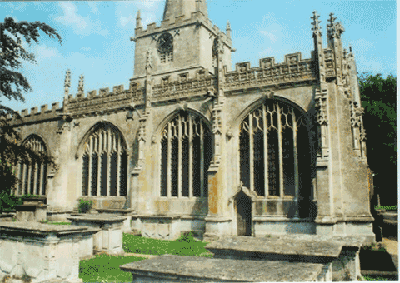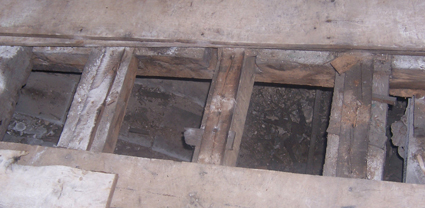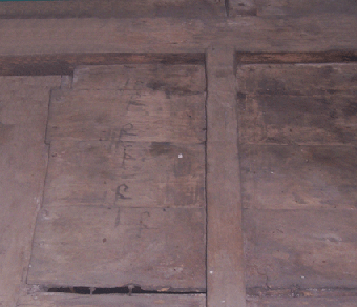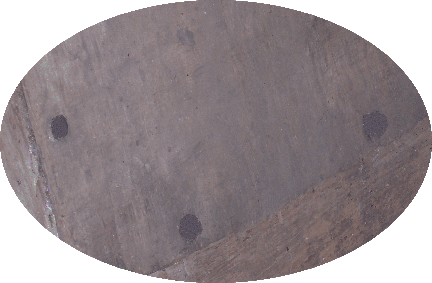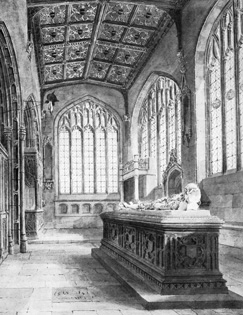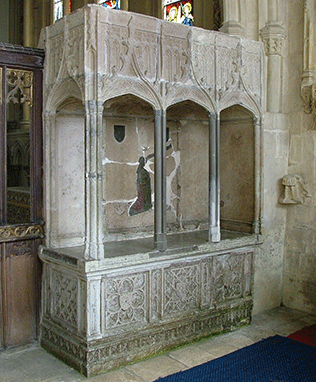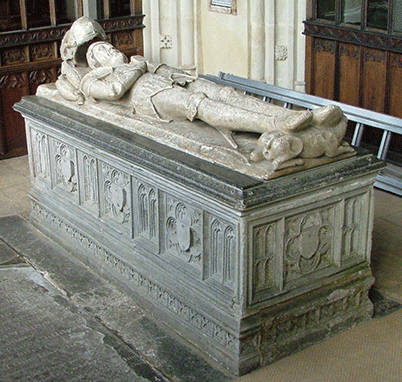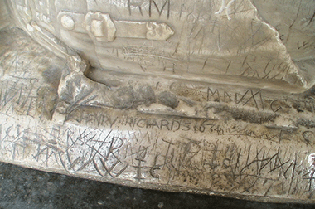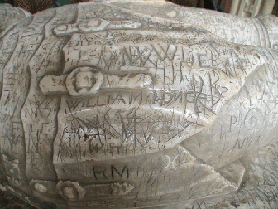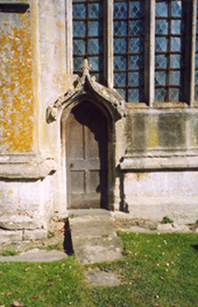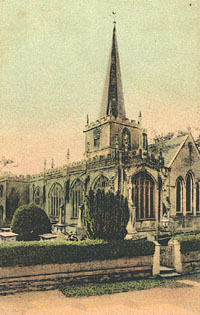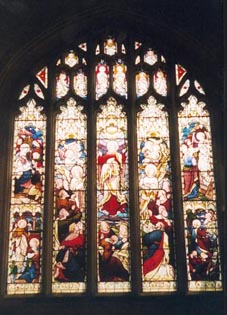
|
|
The Church of St. Nicholas in Bromham village, Wiltshire, is an outstanding example of a unique blend of styles – combining a sound Norman original structure and the superb characteristic of Gothic architecture in its additions. It retains the largest area of original and un-restored medieval timberwork and polychromy (paintwork) in the country. This ancient landmark, dedicated to St. Nicholas, dates back to the early part of the 12th century – with the north and west walls of the nave and the lower part of the tower possibly even older. It retains the largest area of original and un-restored medieval timberwork and polychromy (paintwork) in the country. All that remains of this original structure today is part of the west and north wall of the nave which has two narrow round-headed blocked windows and traces of a blocked round-headed doorway. On the outside of the north wall there are two small Norman-designed windows and a door frame, also early Norman, leading into the vestry which still supports a door that was fitted in the 15th century. It is understood there was another church on this very site, possibly of wooden structure and first reference to a priest dating back to 1086, as he is mentioned in the Doomsday Book and it is likely there was a Saxon church here at that time. The Norman church was originally built in the early part of the 12th century and consisted of a nave and chancel only. Of this part of the west and north walls of the nave remain. The church was rebuilt in the 13th century to incorporate a south transept and central tower, a chantry chapel to the south of the chancel, a south porch with a room above it, an embattled central tower with an octagonal spire and a vestry. The frame of the doorway leading into the sacristy, although now concealed by plaster, is thought to be original from the time the tower was built around the year 1200. It appears the chantry was erected at the same period, and by the same persons, as that attached to St. John's Church at Devizes. The spire is the focal point of the village and it's crowning achievements were the addition of a stupendous spire, stretching over 60 feet above the top part of the tower. In the north wall there are two round-headed windows and the jambs of a doorway of the first work. In 1291 the Church of Bromham was valued at £16. In 1341, it was assessed at the same value but was said actually to be worth less. Today you can see evidence in the form of an early 13th century wall seat beneath the perpendicular large window in the transept. A glass case contains the top of an early 13th century incense boat of limoges enamel and an octagonal font dating back to the 15th century. The frieze and cornice of the exterior of the church are charged with roses, chains and various quarterings of arms and at the ends of the labels, or weather mouldings around the windows are sculptured angels holding shields. The figure of an angel is likewise placed over the east window, supporting figures of children. In the 14th century an aisle and porch were added and sometime later the walls of the nave were made higher and it was re-roofed. In the east angles of the nave are corbels of angels bearing the emblems of the Passion. Over the eastern portion of the nave, where the roof loft was, the roof is panelled and coloured. The ribs are supported on corbel heads. The windows of the nave and aisle are all Third Pointed – at the west a large one of five lights; another similar one on the south; one on the north square headed of three lights and another has lost its tracery. A separate house, which formerly belonged to the church called Church House, was also built in the 1300's and originally consisted of a half-timber construction. Today this building – in High Street – is a private dwelling, but prior to that it was a grocery/bakery shop and in the early 19th century it was used as the Village Poorhouse. The south aisle was built early in the 15th century and had a pitched roof. Also at this time the south porch was built with a room above it.
Although the chapel was first named in honour of the Virgin Mary, it was also known throughout the centuries as the 'Tocotes Chapel', or 'Beauchamp Chapel' or 'Chantry Chapel' in honour of its builders. However because so many of the Bayntun family lie buried in the crypt beneath, and so many of their memorial stones are displayed in this chapel, it is more commonly known today as the Bayntun Chapel. In 2006, permission
was granted to conserve the ceiling of this beautiful chapel, rather
than restore it. This enabled a team of experts to stabilise, clean
and consolidate the surviving paintwork, thus retaining the ceiling's
original features and national importance. Above
this ceiling is a Victorian roof, which was last repaired in 1900-01
and in between, are the medieval timber beams dating back to its original
construction.
It is an interesting example of elaborate and richly decorated Gothic style of the mid 15th century, especially as it retains its original ceiling, window glass, tombs and other features. It is separated from the chancel and transept by contemporary terraced oak screens. The chapel is very similar to the chapel at St. John's in Devizes and has two niches, one on the east and one on the south wall and the exceedingly ornate canopies bear traces of their original colouring.
In 1494 Sir Richard Beauchamp, Lord St. Amand and his wife, Anne, were licensed to give about 80 acres of land at Stockley and 11 acres at Whetham to the Chantry Chapel. It is not clear whether the chantry held all the land at the Dissolution of the Monasteries but some land at Stockley was among the endowments of the chantry concealed from the Crown at the Dissolution. The interior of the chapel is painted and decorated with various gilt figures and from the number of nails fixed in the wall, it is supposed that it was hung round with pieces of armour and warlike trophies; but at present there are only two helmets and two flags, with part of a doublet and gauntlets remaining.
Below the ceiling in the chapel, there are six curved and decorated arched braces, standing on decorative corbels which were found to be bearing a great deal of weight of the ceiling. These were originally meant to be decorative and to take no weight. Before 1500, the south aisle of the church was again under construction when it was altered and the south transept was rebuilt in the same style and the steep-pitched nave roof was replaced with the present one of low pitch to match that of the chantry chapel. Soon after, the upper part of the tower was rebuilt. The tower is 180 feet from its base to the summit of the spire. On the south wall of the chantry chapel you can clearly see the pinnacled buttresses and battlement parapet.
Her inscription reads: Here lyeth Elizabeth, Lady of St. Amand, daughter of Gerald Braybrooke and heiress of Almeric, Lord St. Amand, who died in the year 1491. On whose soul may God have mercy. Amen. It was a fitting resting place for his mother to be the first person to be buried in the chancel built in her name. Her son, Richard Beauchamp died in 1508 – without a male heir – and John Bayntun of Faulston House, his cousin, inherited a fortune in land and property, but more importantly, the Lordship of the Manor of Bromham Roches.
During the English Civil War (1642–1651), the Chapel was used as a stable for the soldiers' horses. During this period some of the soldiers used their blades to inscribe their signature on Sir Roger's tomb. See photos above. The translation reads: Here lyeth Roger Tocotes, Knight, husband of Lady Elizabeth, Lady St. Amand, and Knight of the Body of Henry the Seventh, King of England and Controller of the Household. On whose soul may God have mercy. Amen. The Chapel displays his heraldry and that of his stepson, Sir Richard Beauchamp, and his family including the Bayntuns after whom the Chapel is most commonly named. Although the Beauchamp Chapel is a fascinating insight into the history of the Bayntun family, there were more significant additions to the church following the completion of this chantry chapel of the Blessed Virgin. In 1510 the upper part of the tower, which had crenelated battlements and four bells, was altered and the octagonal stone spire was first built. Since then the spire has had some major repairs to it on four occasions in the last 100 years or so. On the north of the tower is a door having nicely carved woodwork, opening to steps that lead to the roof-loft and also a sacristy. The tower itself rises on three pointed arches, opening to the nave, chancel and south aisle, which are continuous. In that part of the aisle which passes the tower is a five light window. John Bayntun died in 1516 and on the floor, near the tomb of Lady Elizabeth Beauchamp, is a slab bearing a brass effigy of a man in armour, nearly three feet long with an inscription, in Latin, written around the edges. The translation reads: Pray
for the soul of John Bayntun, arminger, son and heir of Robert Bayntun,
knight, kinsman and heir of Richard Beauchamp, Lord St. Amand, who
died the last day of October, anno domini. On whose soul may God have
mercy. Amen.
In 1535 the rectory was valued at £15 - 7s - 4d and at the time of the Dissolution of the Chantries the Beauchamp Chapel was passed onto the crown. The chantry chapel then became the private chapel of the Bayntun family and the chantry house and endowments were leased by the crown to various tenants. Sir Edward Bayntun – son of the above mentioned John Bayntun, in his will, asked to be buried in the same chapel but he died in France in 1544 while attending his Royal Master, King Henry VIII and subsequently his body was never returned. His son – Sir Andrew Bayntun – was another who was not buried in the Beauchamp Chapel and when he died in 1564 his body was laid to rest in St. Andrew's Church, Chippenham, where his badly preserved tomb is in the south chancel, rebuilt as chantry to the Virgin Mary, now known as The Lady Chapel. It is not known why he, or his family, chose St. Andrew's as his final resting place and not the Beauchamp Chapel. The Latin inscription (and translation) on his tomb reads: Armiger hoc tumulo jacet hic generosus opaco, Andreas Baynton qui nominatus erat. Quem genuit miles bene notus ubique Edoardus. Hujus erat heres. Nunc requiescit humo. In this dark tomb lies an arms-bearing gentleman. Who was named Andrew Baynton. Sired by the soldier Edward, knight well known everywhere. He was his heir. Now he reposes this earth. Sir Andrew's brother – Sir Edward Bayntun – inherited the Manor of Bromham when Andrew died without a male heir, and when he died in 1593 he was the next member of the family to be buried in the chapel. His large tomb is very interesting and includes brass figures of a Knight kneeling with his two wives and two of his three children that were alive at the time of their father's death. The brass figure of one daughter is missing. The tomb-crest of this fine marble monument has shields in lozenges and is supported by two columns with brasses against the back wall. The rhyming couplet reads: Here lieth Edward Bayntun, Knight, within this marble clad, by Agnes Ryce, his first trew wyfe, that thyrtyne children had. Where of she left alyve withe him at her departure thre, Henry, Anne and Elizabeth, whose pictures now here see. The XIXth days of Auguste she deceased, of Christ ye year, 1574. These little figurs standing bie present the nomber here. Then married to Anne Packington, his second wyfe she was. For whose remembrance here in tombe these lynes he left in brasse. Anno Dni 1578. Above the tomb of Sir. Edward is the medieval stained glass in the south east window. There are a number of family armorials incorporated in this window, including Roche, Tocotes, Ryce and Roche impaling de la Mare. These armorials were once in the south west window but when the church was re-fenestrated (the windows rebuilt) the glass was moved to the south east window. This work probably took place in the 17th century, although the glass is originally 15th century. The church had suffered considerable damage during the Parliamentary period and extensive repairs were taken in 1661. The windows were broken out, it is thought, after the English Civil War Battle of Roundway, near Devizes. After the battle, Cromwell’s General William Waller, stabled his cavalry in the church and in addition to the glass, a number of statues in niches in the chapel were also hacked out at this time, as was the image of Saint Nicholas on the outer wall. There is no memorial for Sir Edward's son – Sir Henry Bayntun – who died in 1616. He was most likely buried in the crypt below the church and there is a stone insetted in the church floor in honour of his achievements. Sir Henry was responsible for building the The Almshouses – six little cottages for the poor of the town. The memorial stone reads: I was hungry and yee gave mee meate, I was thirstie and yee gave mee drinke, I was naked and yee clothed mee, I was harbarles and yee gave mee lodginge. Come yee blessed of my Father. Inherit the Kingdom prepared for you. Mat 25 Anno Chri 1612 et anno. His son and heir – Sir Edward Bayntun – who died in 1657 is also buried in the crypt. He commanded a force for Parliament in the early part of the first Civil War and was a Commissioner of the English Parliament to the Scots Army. There is a memorial stone in his memory on the north side of the chapel. It reads: Sir
Edward Bayntun, knight, son and heir of Sir Henry Bayntun, Knt. Obit
18 Dec 1657.
In 1671 the rectory also included four houses and their gardens and the Rector had the right to pasture six beasts on the common. Sir Edward's son and heir – another Sir Edward Bayntun – was the next descendant to be laid to rest in the crypt in 1679. The plaque in his memory reads: Sir Edward Bayntun, Knight of the Bath, son and Heir of Sir Edward Bayntun, Knight. Obit 2nd September 1679, Etat. 61. His son and heir – Henry Bayntun – died in 1691, and he too was buried in the crypt along with his wife, Lady Anne Wilmot. There is a plaque in the front chapel under the window in honour of Sir Henry. It reads: Henry Bayntun esq., son and heir of Sir Edward Bayntun, Knight of the Bath. Obit 11th July 1691, Etat. 27. There is a white marble slab in honour of Henry's wife, Lady Anne Wilmot, erected by her children and surmounted by a coat of arms. Her inscription reads: Lady Anne Wilmot, eldest daughter and co-heiress of John, Earl of Rochester. She was the wife of Henry Bayntun Esq. and after his decease, of the Hon Francis Greville. Obit August 8, 1703. Their son – John Bayntun – inherited the Manor of Bromham when only 15 years old, but like his father he too died young, aged only 27 in 1716. He was married but had no children and subsequently his sister, Anne Rolt (nee Bayntun), inherited the family fortune. There is a plaque on the east wall of the chapel in honour of John Bayntun. It reads: John Bayntun Esq, only son and heir of Henry Bayntun Esq, by Lady Anne Wilmot. He was the nineteenth in lineal descent from Sir Henry Bayntun, Knight Marshal of the Household to Henry II. Obit 24 April, 1716 Etat 28.
A spectacular event of the 18th century in Bromham was the visit of a steeple flyer to the church in 1735. His method was to have a long rope fixed from the top of the steeple, passed through a grove in a board, with the other end held, and kept taut, by a number of men standing on the ground and the end of the rope tied to a tree. Running over the rope was a small wheel, having attached to its axle a bar of wood to serve as a “holdfast” for the “flyer” and presumably there was also some apparatus by which the speed could be checked when the man neared the ground. When all was ready the wheel was hauled to the top of the rope, and the flyer who was tied to the board, seized the bar, flung himself into space and came down the rope with terrific speed, amidst the breathless hush of the spectators. But that day, the men who were employed to keep the rope taut, pulled so hard on it that the strain and the weight of the man proved too much for the steeple, which broke away as he was half way down. The performer hanging on the rope, was thrown into a tree in the churchyard, but fortunately escaped with very slight injuries. However the upper part of the spire was damaged, being pulled to the ground and subsequently had to be replaced at this time. A poetic account
written at the time describes the event as: In the mid-18th century the number of bells in the tower was increased from four to six at a cost of £820. It is not known when the first clock was incorporated in the tower but an account for the cleaning of the church clock is dated 1743 and a painting of the church by Buckler some years later shows the old clock with a diamond-shaped face. The churchwardens accounts mentions "For cleansing the clock = 7s - 6d". Anne Bayntun's son – Sir Edward Bayntun Rolt – inherited the Manor of Bromham upon the death of his uncle, John Bayntun, when only 6 years old and the remainder of the Bayntun fortune when his mother died in 1734. He was Lord of the Manor for 83 years and when he died in 1800 he was buried in the family crypt alongside his wife who died a year earlier. There is a tablet, in his memory, draped on a black slab on the south wall of the chapel. It reads: Here rest the remains of Sir Edward Bayntun Rolt Bart, second son of Edward Rolt of Sacombe Park in the county of Herts Esq. and nephew and heir of John Bayntun of Spye Park, in the county of Wilts Esq. who died January 3rd 1800 aged 89. Also of Dame Mary his wife who died March 26th 1799 aged 81. Elizabeth, the daughter of Sir Edward, had died just 6 months before her mother and was also buried in the Bayntun crypt. The inscription reads: Here lyeth the body of Elizabeth, daughter of Sir Edward Bayntun Rolt, Bart of Spye Park, Co. Wilts, by Mary his wife, and the wife of Henry Stone, Esq., of Bradbury Manor in the same county. She was born the 13th of March 1758 and died the 25th of September 1798. When Sir Edward's son and heir – Sir Andrew Bayntun Rolt– died in 1816, he was also laid to rest in the crypt below the chapel. A tablet draped on a black slab reads: Here rest the remains of Sir Andrew Bayntun Rolt of Spye Park, Bart, only son of the late Sir Edward Bayntun Rolt, Bart. He married first Maria, daughter of George William, Seventh Earl of Coventry and secondly Anna Maria Maud. He died 12th August 1816, aged 61 Leaving one daughter by his first wife. Following his death, his daughter, Maria Barbara Bayntun Rolt was named as his only legal heir and his grandson – John Edward Andrew Bayntun Starky – became Lord of the Manor of Bromham. There is no record as to the whereabouts of Maria Barbara's remains and it is unclear if she is buried with the Bayntuns. She did remarry John Lowe and is quite possibly buried elsewhere. On the east side of the chapel, there are two stones on the floor, side by side, in memory of Maria Barbara and John Starky's children. Both had predeceased their father. These inscriptions read: To the memory of George William, the second son of the Revd. John Starky DD. He died on the 30th April 1816 aged 15. He was buried in London. To the memory of Maria Barbara, second daughter of the Revd. John Starky DD. She died on the 31st May 1825, aged 20 years. She was buried at Ryde, Isle of Wight. When their father died, he too was buried in the Bayntun crypt. His inscription reads: Underneath lie the remains of the Revd. John Starky D.D. of Spye Park, Wilts and Rector of Carlinch, Somerset. He died the 1st of April 1834 aged 64 years. He married Maria Barbara, only daughter and heiress of Sir Andrew Bayntun Rolt, Bart. of Spye Park by whom he had ten children. When John Edward Andrew Bayntun Starky died in 1843, he too was also laid to rest with the others. His plaque reads: Underneath lie the remains of John Edward Andrew Starky of Spye Park, Wilts, Esq., eldest son of the Revd. John Starky DD. Born 6th March 1799, died 12th January 1843, aged 43 years and 10 months. He married on the 17th April 1833, Charlotte, the fifth daughter of William Wyndham Esq., of Dinton, in this county by whom he had four children of whom three survived him – two sons and one daughter. John Edward Andrew Starky's second son died four days after birth and there is a stone in his memory in the south side of the chapel on the floor. It reads: Underneath lie the remains of Edward, the second son of John Edward Starky Esq and Charlotte his wife. He was born on the 28th November 1835 and died on the 2nd December 1835. "We all do fade as a leaf".
Early in the 19th century, the south aisle and porch were partly rebuilt. In 1843 the sacristy was added to the north wall of the tower. The same year the old church box pews were removed and replaced and a new pulpit and reading desk were provided. This reading desk has now been removed to the churchyard.
When Thomas Moore, the Irish poet, died in 1852 there was an large Celtic cross erected in the churchyard in his memory, which stands 18 feet high. Moore lived nearby for 35 years. The west window in the nave is also in his memory. In 1855 the Rev. W.C. Lukis recorded the inscriptions on the church bells. The first, third and fifth bells bore the initials of the maker – William Purdue – and the six bells weighed a total of 2 tons, 14 cwts, 3 qts and 18 lbs. When the chancel was rebuilt in 1864, several monuments were removed to other parts of the church. In 1865 the 12th century chancel was declared unsafe and was demolished and completely rebuilt exactly as the original construction at the expense of the Rector. Several monuments were removed at this time to other parts of the church. In 1870 a superb example of 19th century glass was installed in the west window representing the Last Judgment which was erected in memory of the poet, Thomas Moore. Another of Maria Barbara's sons – Coventry – is also remembered in the chapel with the following verse: In memory of Coventry Starky, the fourth son of Maria Barbara Bayntun Rolt and the Revd. John Starky. He died on the 2nd April 1871, aged 61 years. In 1871 the clock was again replaced. An extract from an edition of the North Wilts Church Magazine, dated September 1871, reads: "During the past month, the old clock at Bromham Church, which had been up more than a hundred years, has been taken down and replaced by a new one at a cost of 100 guineas". The Bayntun Starky family were settled in New Zealand at this time, having first emigrated to NSW in Australia. There are memorials to some of these descendants, including that of John Bayntun Starky – the last Lord of the Manor of Bromham to live in Bromham. In 1875. The Medieval pearl of six bells were all recast– the earliest dating back to 1657 – and were re-hung on new frames.
This is known as the east window and is in the later gothic perpendicular style. The three centre lights depict the Ascension, with full-length figures of the Lord in the centre light. Below him are grouped three figures of the Virgin Mary and two apostles and in the lights either side of this are two full-length figures of angels in white apparel and six part figures of angels. In the lower half of these lights are five apostles on the north and four apostles on the south, all looking upwards. In the north light, the upper portion shows three shepherds paying homage to the Infant Jesus. In the lower portion is shown 'The Annunciation' – the Virgin Mary, at prayer, she gazes over her shoulder at the Angel Gabriel. In the south light upper portion – 'The Visit to the Sepulchre' – an angel is indicating to the empty tomb. In the lower portion is the 'Garden of Gethsemane' – Christ looks towards an angel and below him are three sleeping disciples. The small spaces above are filled in with figures of angels. In 1875 the medieval pearl of six bells were taken down and recast and again re-hung in new frames and fittings by John Warner & Sons of London at a cost of £364 - 9s - 6d. The earliest of these dated back to 1657. Queen Victoria made a contribution of £100 towards the cost. The new bells had a combined weight of 3 tons 5 cwts, 1 qt, 27 lbs. In 1879 a new organ was erected, which replaced an older model of 1848. It was made by Foster & Andrews of Hull at a cost of £300. John Edward Starky's wife – Charlotte Wyndham – outlived her husband by over 50 years and after her death she joined him in his final resting place. She was 90 years old and the last person to be buried in the Bayntun crypt in 1896. There is a painted glass window in the chapel in her honour with the inscription: In affectionate memory of Charlotte, widow of John Edward Starky Esq. Died 20th October 1896 aged 90 years. Her children arise up and call her blessed. Following Charlotte's death, the vault below the chapel was sealed up permanently with a large stone (measuring 2 metres x 1 metre). This vault was used from 1492 until 1896 and the Bromham Burial Records did not start until 1560. But even these records do not include everybody who went into the vault and those buried in the churchyard. It is very likely there were many other members of the Bayntun family laid to rest there, unaccounted for, especially the children of the various generations throughout the centuries. In 1899 the top of the spire was rebuilt, for the first time since it's erection. In 1901 the church estate consisted of six cottages in Church Row and shops and houses elsewhere in Bromham. Its origin was not known, but it was then stated that accounts relating to the property went back as far as 1783. The income was used by the churchwardens for general expenses. In 1905 the chapel roof underwent some major repair and was re-leaded. In the early twentieth century, the Irish curate at St Nicholas Church, Rev. A. S. Hartigan, thought that Thomas Moore deserved a better tomb than the plain slab that marked his resting place at that time. He organised a collection and a Memorial Committee was formed which included Sir Arthur Conan Doyle. The new monument – a Celtic Cross – was dedicated in October 1906. It had been made by Harrison and Sons of Blackrock, Dublin. In 1911 a second face was added to the church clock to mark the Coronation of King George V. In 1913 an oak case to the instrument and the organ stool was given by Rev. J.L. and Mrs. Thorold. In 1920 the walls of the nave and aisles were enhanced and refitted with some new oak paneling. John Bayntun Starky's wife, Frances Anne, died in 1921 and a memorial stone in her memory was erected in the chapel. It reads: Frances Anne, wife of John Bayntun Starky. Died 29 March 1921, aged 86. Buried at Instow, Devon. In 1932 the spire was again repaired. In 1947 an electric blower was added to the church organ. In 1949 the bells were again re-hung and new timbers were added to support them. In 1952 the spire needed some more work done to it. In 1957 a thorough cleaning of the church revealed many interesting features. In 1971 there was a memorial stone insetted in memory of John Michael Bayntun Starky who died in Brackenfield, New Zealand the same year. It reads: In memory of John Michael Bayntun Starky, only son of John Bayntun Starky. Born 18th October 1909. Died 18th November 1971. In 1986 the nave and aisle were re-roofed and a new stone floor laid in the nave and transept. In 1987 the spire needed some more work done to it and the church was re-floored at the same time. The vault of the Banks family was accidentally exposed during this project, revealing the brass-studded, leather covered coffins and vault stones in excellent condition. The vault and its contents were left untouched and the new floor laid on top. In 1990 the bells were taken down, re-tuned and supplied with new fittings and again re-hung on the same frame. This work was carried out by John Taylor of Loughborough. |
